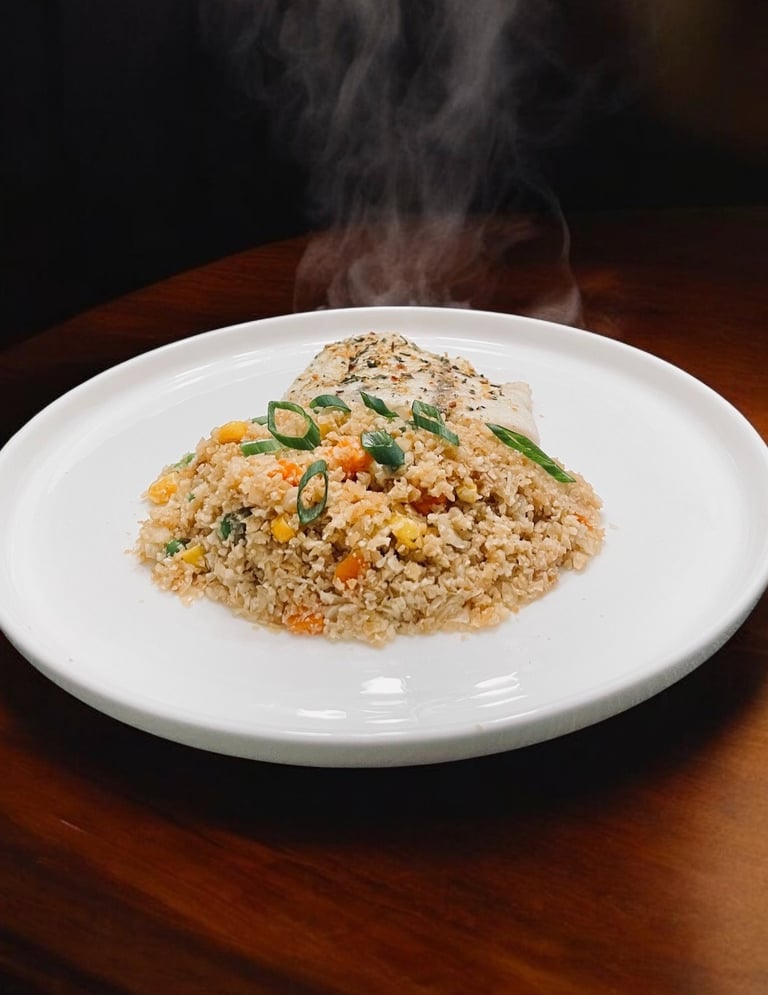Asian Rice Cauliflower
Light yet satisfying, this Asian-inspired cauliflower rice is a low-carb, nutrient-packed alternative to traditional rice. Perfectly sautéed with vibrant mixed vegetables, sesame oil, and tamari sauce, it offers a delicious, savory dish that is easy to prepare and full of flavor.
EASY TO MAKEVEGETARIANSIDE DISH
Lourdes Rodriguez
4/10/20253 min read


History of Rice Cauliflower
Cauliflower rice is a modern, healthy alternative to traditional rice, popular in low-carb, gluten-free, and paleo diets. It has gained significant attention due to its ability to replicate the texture and versatility of rice while being much lower in calories and carbohydrates. The addition of Asian-inspired flavors such as sesame oil, tamari, and ginger elevates this simple dish into a satisfying and nutritious meal.
Health Benefits of Asian Rice Cauliflower
Low Carb: Cauliflower rice is an excellent choice for those on a low-carb or ketogenic diet. It offers all the fiber and antioxidants of cauliflower without the added carbohydrates of traditional rice.
Rich in Nutrients: Cauliflower is packed with vitamin C, K, and B6, and is a good source of fiber, folate, and antioxidants, which are important for overall health.
Digestive Health: The fiber in cauliflower aids digestion and supports gut health.
Low in Calories: This dish is low in calories, making it an excellent option for those looking to reduce their calorie intake while still enjoying a flavorful meal.
Tips for Making the Best Asian Rice Cauliflower
Texture Control: When using fresh cauliflower, make sure to pulse it in small batches in the food processor to ensure an even "rice" texture. Avoid over-processing, as it can turn into mush.
Frozen Cauliflower Rice: If using frozen cauliflower rice, be sure to defrost it fully before cooking to prevent excess moisture from ruining the texture.
Ginger Alternatives: If you don't have ginger juice, freshly grated ginger works just as well. Adjust the amount based on your taste preferences.
Heat Control: Always sauté the cauliflower rice over medium heat to prevent burning and maintain a pleasant texture.
The Best Season to Enjoy
This dish is versatile and can be enjoyed year-round, but it pairs particularly well with warm meals during cooler months. The flavors of ginger and sesame oil make it comforting in fall and winter, while the fresh veggies make it a light, refreshing dish for spring and summer.
Asian Rice Cauliflower Recipe
Yield: 2 servings
Ingredients:
1 small cauliflower head
1 cup frozen mixed vegetables
1 Tbsp. sesame oil
½ tsp. minced garlic
1 Tbsp. low-sodium tamari sauce
½ tsp. ginger juice
1 green onion, sliced
Instructions:
Prepare the Cauliflower Rice: Coarsely chop the cauliflower. Place the cauliflower pieces in two batches in a food processor. Pulse for 12 seconds or until it has a rice-like texture.
Cook the Vegetables: In a small pot, bring water to a boil. Add the frozen mixed vegetables and cook for 4 minutes. Drain them, then place in an ice bath to stop the cooking process and preserve their vibrant colors. Drain and reserve.
Sauté the Cauliflower Rice: Heat 1 tablespoon of sesame oil in a large skillet over medium heat. Add the minced garlic and sauté for 1 minute until fragrant.
Add Cauliflower Rice: Add the cauliflower rice to the skillet and sauté for 2 minutes.
Add the Sauces: Stir in the tamari sauce and ginger juice. Cook for 1 minute, ensuring the cauliflower rice is evenly coated with the sauce.
Combine Vegetables: Add the cooked mixed vegetables to the skillet and stir until they are heated through.
Garnish & Serve: Serve hot, garnished with sliced green onions.
Notes:
Storage: Store any leftover Asian rice cauliflower in an airtight container in the fridge for up to 3-4 days. Reheat in a skillet over medium heat to preserve the texture.
Freezing: You can freeze the cauliflower rice before cooking it, but avoid freezing the cooked dish, as the texture may change when reheated.
Suggestions for Swap Ingredients:
Vegetables: Swap frozen mixed vegetables for fresh vegetables like peas, carrots, or bell peppers.
Tamari Sauce: For a gluten-free alternative, use coconut aminos instead of tamari sauce.
Ginger Juice: Fresh ginger can be grated and added to the dish in place of ginger juice.
Ideas to Pair:
Main Dish: Pair with grilled chicken, shrimp stir-fry, fish, or tofu for a complete meal.
Some Individuals May Need to Limit or Avoid This Recipe:
People with Hypothyroidism: Cauliflower is a goitrogenic food, meaning it can interfere with thyroid function when consumed in large amounts. Individuals with thyroid conditions like hypothyroidism should consult with a healthcare provider before consuming large quantities of cauliflower.
FODMAP Sensitivity: Those with sensitive digestive systems (especially those on a low FODMAP diet) may want to limit cauliflower as it can cause bloating and gas.
Important: If you have any doubts about incorporating this food into your diet, it is always a good idea to consult with your dietician or doctor.
Plenitaste
Inspiring healthy, global recipes for everyone.
contact me:
Recipe
plenitaste@gmail.com
© 2025. All rights reserved.
